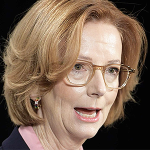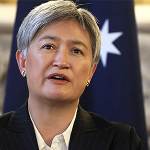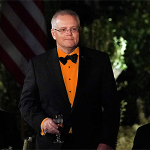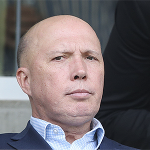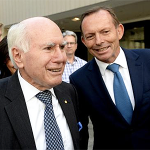Prime Minister Anthony Albanese characterised the US steel tariff to be imposed on Australia as ‘entirely unjustified’. That might be considered patriotic, but such a categorical claim is an obvious exaggeration.
There are two key issues here: first, whether the US should impose a steel tariff at all; and second, if they do, whether Australia should be exempted.
It is difficult to argue that Trump lacks a mandate for tariffs. They were a signature policy in his election campaign, repeatedly outlined in his rallies. His main argument is that tariffs will help revive US manufacturing jobs.
At one time, the US steel industry employed 650,000 workers. Now, that figure stands at around 140,000. In 1950, the US produced approximately 47 per cent of global steel output. By 2023, this had fallen to about 5 per cent, while China now accounts for roughly 53 per cent of total production.
Neither is there any dispute over Trump’s legal authority to impose tariffs on imports. He also argues that tariff revenue will help support income tax cuts.
Additionally, there is a reasonable national security argument that a robust domestic steel industry is critical. In times of significant military conflict, trade routes become uncertain, and steel is the backbone of military hardware and infrastructure repair.
On the other hand, economists rightly highlight the second-order effects of tariffs: higher consumer prices, increased inefficiency, and relative disadvantages for industries that rely on imported steel. These concerns are valid, but they do not automatically mean the US will be a net loser from imposing tariffs. The benefits and costs must be weighed against each other.
If we accept that the US has a legitimate right to impose tariffs, the next question is whether there is a strong case for Australia to receive an exemption. From the US perspective, the rationale for such a carve-out is weak.
One of the stated objectives of the tariff is to increase US steel production. If Australia remains exempt, as with aluminium exports, our exports will continue to pose a competitive threat to US industry and jobs in aluminium production, undermining the policy intent.
Further complicating Australia’s position is the perception that we breached an agreement with the US not to expand aluminium production following the first Trump administration’s tariff exemptions.
Howard Lutnick, the US Commerce Secretary, publicly claimed that Australia was dumping subsidised aluminium into the US. Peter Navarro, a senior Trump trade adviser, has made similar accusations. While no official ruling has confirmed these allegations, their persistence in Washington weakens Australia’s position.
Another argument often made for preferential treatment is Australia’s history of supporting the US in military conflicts since the first world war. However, this argument warrants careful scrutiny.
It is true that Australia has joined US-led coalitions, but there has always been a clear national interest rationale for doing so. Perhaps the Vietnam War is the one exception. The broader point is that Australia’s military alliance with the US is based on strategic considerations, not simply an act of goodwill that should entitle us to trade benefits.
If Australia were setting an example in contributing to Indo-Pacific security, this might enhance our leverage in trade negotiations. However, the raw statistics on defence spending are not favourable. In 2022, Australia’s defence spending was just 1.9 per cent of GDP, having fallen as low as 1.5 per cent over the past three decades. By contrast, the US allocates 3.4 per cent of its GDP to defence.
The impact of this under-investment is evident. When a Chinese naval task group, including the Type 054A frigate Hengyang, conducted live-fire exercises in the Tasman Sea, Australia’s capacity to shadow the flotilla with warships was limited. While trade and defence should not be directly linked, such disparities in defence contributions shape broader perceptions in Washington about Australia’s commitment to the alliance.
Beyond these structural factors, Australia’s trade bargaining position may also be subtly undermined by a series of diplomatic missteps. While individually minor, these issues collectively may signal a lack of respect for the US and may influence Washington’s decisions at the margins.
Kevin Rudd was appointed as Australia’s Washington Ambassador despite having left critical tweets about Donald Trump on his social media account throughout the US election period—deleting them only after the result was clear. This was an avoidable diplomatic error.
Similarly, Foreign Minister Penny Wong has repeatedly used UN votes to undermine US and Israeli positions on Middle East issues, departing from Australia’s longstanding history of aligning with the US in such matters.
Before the steel tariff decision, former Prime Minister Malcolm Turnbull made some regrettable comments about Trump. As a former head of government, his comments may have raised questions in Washington about broader sentiment in Australia’s political class.
Then there is the case of Western Australia Premier Roger Cook, who publicly called US Senator J.D. Vance a ‘knob’. This was particularly reckless given that the US has agreed to station nuclear-powered submarines in Western Australia under Aukus – a significant strategic commitment to Australia’s security.
Instances like these raise an important question: When was the last time a senior US politician launched an unprovoked personal attack on a prominent Australian leader? It simply does not happen. If Australia expects to be treated as an exceptionally close ally, it must behave accordingly.
The steel tariffs are an adverse development for Australia, but they are neither surprising nor entirely unjustified. While the US has its own domestic rationale for these measures, Australia must recognise that its own decisions – on trade, defence, and diplomacy – play a role in shaping its ability to secure special treatment in Washington.
Nick Hossack is a public policy consultant. He is former policy director at the Australian Bankers’ Association and former adviser to Prime Minister John Howard.


